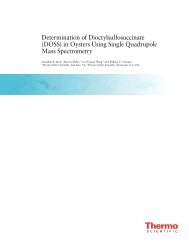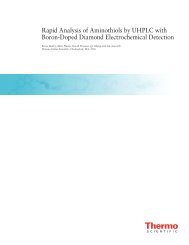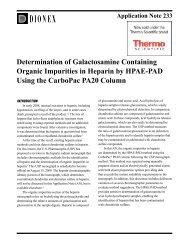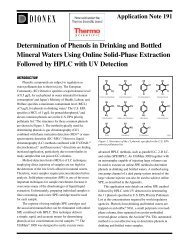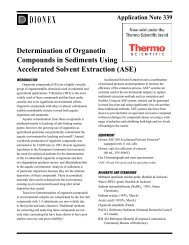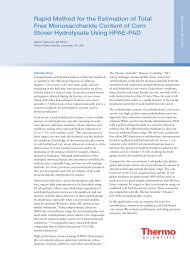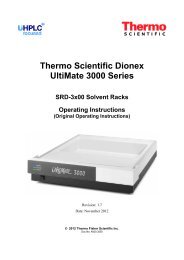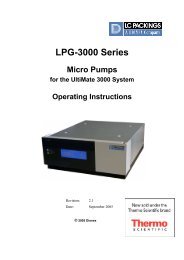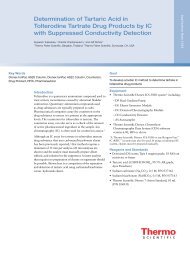Determination of Mono-, Di-, and Triphosphates and Citrate ... - Dionex
Determination of Mono-, Di-, and Triphosphates and Citrate ... - Dionex
Determination of Mono-, Di-, and Triphosphates and Citrate ... - Dionex
You also want an ePaper? Increase the reach of your titles
YUMPU automatically turns print PDFs into web optimized ePapers that Google loves.
<strong>Determination</strong> <strong>of</strong> <strong>Mono</strong>-, <strong>Di</strong>-, <strong>and</strong><br />
<strong>Triphosphates</strong> <strong>and</strong> <strong>Citrate</strong> in Shrimp by<br />
Ion Chromatography<br />
Chanita Chantarasukon, 1 Suparerk Tukkeeree, 1 <strong>and</strong> Jeff Rohrer2 1 2 Thermo Fisher Scientific, Bangkok, Thail<strong>and</strong>; Thermo Fisher Scientific, Sunnyvale, CA, USA<br />
Key Words<br />
Reagent-Free IC (RFIC), Food, <strong>Di</strong>onex IonPac AS11 Column,<br />
<strong>Di</strong>onex InGuard HRP Cartridges, Seafood<br />
Introduction<br />
Polyphosphates are legally added to some food products<br />
such as meat, fish, <strong>and</strong> seafood. In the seafood industry,<br />
polyphosphates are used in both fresh <strong>and</strong> frozen<br />
products to increase their water-binding capacity. This<br />
improves the appearance <strong>and</strong> texture <strong>of</strong> the product <strong>and</strong><br />
also increases the weight <strong>of</strong> the seafood. Polyphosphates<br />
are legal, but some countries require that polyphosphate<br />
usage be declared <strong>and</strong> may also limit the amount that can<br />
be added. For example, Switzerl<strong>and</strong> has set the maximum<br />
concentration at 5 g per kg. The polyphosphates typically<br />
used in foods such as shrimp are small, containing two or<br />
three phosphate units, <strong>and</strong> they are <strong>of</strong>ten hydrolyzed to<br />
orthophosphate before the food is eaten. Citric acid is<br />
sometimes added to shrimp as a preservative to maintain<br />
an acidic environment.<br />
Ion chromatography (IC) is commonly used to determine<br />
both large (>3 phosphates) <strong>and</strong> small polyphosphates, as<br />
well as citrate. An early study used a Thermo Scientific<br />
<strong>Di</strong>onex IonPac AS7 Anion-Exchange Column to<br />
determine triphosphosphate <strong>and</strong> its hydrolysis products<br />
in shrimp. 1 This method used a nitric acid eluent <strong>and</strong><br />
a postcolumn reaction with ferric nitrate to produce<br />
UV-absorbing products for phosphate-containing analytes,<br />
rather than suppressed conductivity detection. Since<br />
then, <strong>Di</strong>onex (now part <strong>of</strong> Thermo Scientific) Application<br />
Note 71 demonstrated that polyphosphates can be<br />
separated using a hydroxide eluent gradient on the<br />
<strong>Di</strong>onex IonPac AS11 Hydroxide-Selective Anion-<br />
Exchange Column <strong>and</strong> detected by suppressed<br />
conductivity. 2 More recently, <strong>Di</strong>onex (now part <strong>of</strong><br />
Thermo Scientific) Application Update (AU) 172 showed<br />
that the <strong>Di</strong>onex IonPac AS16 Hydroxide-Selective<br />
Anion-Exchange Column was a better choice for<br />
separating large polyphosphates. Furthermore, AU 172<br />
demonstrated that if the sample did not have larger<br />
polyphosphates or they did not need to be measured, the<br />
method could be paired with an eluent generator (i.e., a<br />
Reagent-Free IC [RFIC ] system) to free the analyst<br />
from preparing hydroxide eluents <strong>and</strong> achieve consistent<br />
results. 3<br />
The introduction to AU 172 describes the application<br />
<strong>of</strong> IC to determining polyphosphates in a variety <strong>of</strong><br />
samples, including fish <strong>and</strong> shell fish, using the <strong>Di</strong>onex<br />
IonPac AS11 <strong>and</strong> AS16 columns as well as the <strong>Di</strong>onex<br />
IonPac AS11-HC column. Two <strong>of</strong> those publications<br />
that focused on fish <strong>and</strong> shrimp were from Swiss<br />
government laboratories, each using the <strong>Di</strong>onex<br />
IonPac AS16 column <strong>and</strong> a hydroxide gradient with<br />
suppressed conductivity detection, <strong>and</strong> one using an<br />
eluent generator. 4,5<br />
Because the goal here was to measure only the small<br />
polyphosphates, an IC method was developed that used<br />
an eluent generator. Thus, the analyst must only add<br />
deionized water to the system to prepare the eluents<br />
necessary for accurately measuring small polyphosphates<br />
<strong>and</strong> citrate in shrimp. Additionally, the sample<br />
pretreatment required for this analysis to maintain good<br />
chromatography <strong>and</strong> extend column lifetime has been<br />
automated so that it is done on-line using a Thermo<br />
Scientific <strong>Di</strong>onex InGuard cartridge.<br />
Goal<br />
To determine small polyphosphates <strong>and</strong> citrate in<br />
shrimp using IC<br />
Application Note 1007
2<br />
Equipment<br />
• Thermo Scientific <strong>Di</strong>onex ICS-3000 system* including:<br />
– DP Dual Pump<br />
– DC Detector Chromatography Compartment<br />
– EG Eluent Generator<br />
– AS Autosampler with Cooling Option<br />
– <strong>Di</strong>onex InGuard HRP Cartridges, package <strong>of</strong> 4<br />
(P/N 074034)<br />
– EWP Electrolytic Water Purifier (P/N 071553)<br />
• PC-100 Pump Controller (Trovion P/N 590100)<br />
• Thermo Scientific <strong>Di</strong>onex Chromeleon<br />
Chromatography Data System s<strong>of</strong>tware version<br />
6.80, SR9 or above<br />
*A Thermo Scientific <strong>Di</strong>onex ICS-5000 or any RFIC system<br />
may also be used.<br />
Reagents <strong>and</strong> St<strong>and</strong>ards<br />
• Deionized (DI) water, Type I, reagent grade, 18 MΩ-cm<br />
resistivity or above<br />
• Trisodium orthophosphate (Na PO ·12H O,<br />
3 4 2<br />
98.0–102%, AR grade, Ajax Finechem)<br />
• Citric acid (C H O ·H O, 99.0–102.0%, AR grade,<br />
6 8 7 2<br />
Ajax Finechem)<br />
• Tetrasodium pyrophosphate (Na P O ·10H O,<br />
4 2 7 2<br />
99.0–103%, AR grade, Ajax Finechem)<br />
• Trisodium trimetaphosphate (Na O P , 100%, AR<br />
3 9 3<br />
grade, Sigma-Aldrich ® )<br />
• Sodium triphosphate pentabasic (Na O P , ≥ 98.0%,<br />
5 10 3<br />
AR grade, Fluka)<br />
• Potassium hydroxide solution, 8 M (KOH, AR grade,<br />
Kanto)<br />
Preparation <strong>of</strong> Solutions <strong>and</strong> Reagents<br />
Eluent<br />
The eluent generator (EG) produces the eluent using<br />
the Thermo Scientific <strong>Di</strong>onex EGC II KOH EluGen<br />
cartridge <strong>and</strong> DI water supplied by the pump. The eluent<br />
concentration is controlled by Chromeleon s<strong>of</strong>tware.<br />
The EG degasser requires 14 MPa (2000 psi) system<br />
backpressure, which ensures optimum removal <strong>of</strong><br />
electrolytic gas produced by the EG cartridge. For more<br />
information about adding system backpressure, refer<br />
to the ICS-3000 systems operator’s manual, Document<br />
No. 065031, or any other RFIC system operator’s manual.<br />
Stock St<strong>and</strong>ard Solutions, 1000 mg/L<br />
<strong>Di</strong>ssolve the appropriate weight <strong>of</strong> the salt listed in<br />
Table 1 into separate 100 mL volumetric flasks with<br />
DI water. Add 0.25 ml <strong>of</strong> 8 M KOH <strong>and</strong> bring to the<br />
volume with DI water.<br />
Table 1. Preparation <strong>of</strong> 100 mL <strong>of</strong> 1000 mg/L st<strong>and</strong>ard<br />
St<strong>and</strong>ard Salt Weight (g)<br />
Orthophosphate Trisodium orthophosphate 0.400<br />
<strong>Citrate</strong> Citric acid 0.109<br />
Pyrophosphate Tetrasodium pyrophosphate 0.268<br />
Trimetaphosphate Trisodium trimetaphosphate 0.129<br />
Triphosphate Sodium 0.145<br />
Table 2. Preparation <strong>of</strong> working st<strong>and</strong>ards<br />
Level<br />
Concentration<br />
(mg/L)<br />
Volume <strong>of</strong> 1000 mg/L Stock<br />
St<strong>and</strong>ard Solution for 100 mL<br />
Preparation (mL)<br />
1 0.5 0.05<br />
2 1.0 0.10<br />
3 2.0 0.20<br />
4 3.0 0.30<br />
Working St<strong>and</strong>ard Solutions<br />
Add the appropriate volume <strong>of</strong> each 1000 mg/L stock<br />
st<strong>and</strong>ard solution into separate 100 mL volumetric flasks,<br />
add 0.25 mL <strong>of</strong> 8 M KOH, <strong>and</strong> bring to volume with<br />
DI water. Table 2 lists working st<strong>and</strong>ard concentrations<br />
<strong>and</strong> the volumes <strong>of</strong> 1000 mg/L stock st<strong>and</strong>ard solution<br />
used for each concentration level.<br />
Sample Preparation<br />
Puree the shrimp sample <strong>and</strong> weigh 0.2 g <strong>of</strong> the sample into<br />
a 100 mL bottle. Add 99.75 mL <strong>of</strong> DI water <strong>and</strong> 0.25 mL <strong>of</strong><br />
8 M KOH, shake, <strong>and</strong> place in ultrasonic bath for 5 min.<br />
Filter with a 0.45 µm syringe filter prior to injection.<br />
Chromatographic Conditions<br />
Column: <strong>Di</strong>onex IonPac AS11 Analytical,<br />
4 × 250 mm (P/N 044076)<br />
Guard: <strong>Di</strong>onex IonPac AG11 Guard, 4 × 50 mm<br />
(P/N 044078)<br />
Cartridge: <strong>Di</strong>onex InGuard HRP, 9 × 24 mm (P/N 074034)<br />
Trap Column: <strong>Di</strong>onex IonPac UTAC-LP1 Ultra Trace Anion<br />
Concentrator - Low Pressure, 4 × 35 mm<br />
(P/N 063079)<br />
Eluent Source: <strong>Di</strong>onex EGC III KOH EluGen potassium hydroxide<br />
(P/N 074532) with Thermo Scientific <strong>Di</strong>onex<br />
CR-ATC Continuously Regenerated Anion<br />
Trap Column (P/N 060477)<br />
Gradient: See Table 3<br />
Flow Rate: 1.0 mL/min<br />
Inj. Volume: 25 µL<br />
Pressure: ~2000 psi<br />
Sample Tray Temp.: 10 °C<br />
Column Temp.: 35 °C<br />
Detection: Suppressed conductivity with Thermo Scientific<br />
<strong>Di</strong>onex ASRS 300 Anion Self-Regenerating<br />
Suppressor, 4 mm (P/N 064554), external<br />
water mode, current 130 mA
Results <strong>and</strong> <strong>Di</strong>scussion<br />
The on-line sample treatment is performed using a<br />
<strong>Di</strong>onex InGuard HRP cartridge. The RFIC system<br />
passes the prepared shrimp samples through the <strong>Di</strong>onex<br />
InGuard HRP cartridge to trap hydrophobic compound<br />
that can foul the analytical column. Orthophosphate,<br />
pyrophosphate, trimetaphosphate, triphosphate, <strong>and</strong><br />
citrate are then separated on the <strong>Di</strong>onex IonPac AS11<br />
column <strong>and</strong> detected by suppressed conductivity in<br />
15 min. Overall, this is an efficient way to determine these<br />
compounds in shrimp as it eliminates time-consuming<br />
<strong>of</strong>f-line sample preparation.<br />
Separation<br />
<strong>Citrate</strong>, phosphate, <strong>and</strong> polyphosphates are anions<br />
that are strongly retained on moderate or high-capacity<br />
anion-exchange columns. Thus, a high eluent<br />
concentration or long run time will be required to elute<br />
them from the column. For these analytes, it is <strong>of</strong>ten<br />
advantageous to use a low-capacity column designed for<br />
fast elution <strong>of</strong> species that are strongly retained on many<br />
anion-exchange columns, such as the <strong>Di</strong>onex IonPac AS11<br />
column. Phosphate species <strong>and</strong> citrate are separated using<br />
a gradient <strong>of</strong> potassium hydroxide eluent with the highest<br />
eluent concentration, 50 mM, easily suppressed for<br />
conductivity detection. Common <strong>and</strong> other anions that<br />
are mono- <strong>and</strong> divalent elute before the phosphate<br />
species <strong>and</strong> citrate, <strong>and</strong> thus do not interfere with their<br />
determination. Figure 1 shows the separation <strong>of</strong><br />
phosphate species <strong>and</strong> citrate.<br />
Method Calibration<br />
The method was calibrated before sample analysis using<br />
four different concentrations <strong>and</strong> three injections <strong>of</strong> each<br />
concentration. It is difficult to obtain polyphosphate in a<br />
pure form. Phosphate species that have lower numbers <strong>of</strong><br />
phosphate units are typically present, so it is better to<br />
calibrate the method using a single-component working<br />
st<strong>and</strong>ard. For this application, working st<strong>and</strong>ards were<br />
prepared in 20 mM potassium hydroxide. This slows<br />
the hydrolysis <strong>of</strong> the polyphosphate species <strong>and</strong> also<br />
stops growth <strong>of</strong> microorganisms that can degrade the<br />
st<strong>and</strong>ards (because phosphate is a necessary nutrient for<br />
microorganisms). Table 4 shows the calibration results for<br />
the five st<strong>and</strong>ard analytes.<br />
Table 4. Calibration st<strong>and</strong>ard concentrations <strong>and</strong> calibration results<br />
Table 3. Gradient program<br />
Time (min) KOH Conc. (mM)<br />
-5.0 30<br />
3.0 30<br />
3.1 45<br />
7.0 45<br />
7.5 50<br />
12.9 50<br />
13.0 30<br />
Column: <strong>Di</strong>onex IonPac AS11 Analytical, 4 × 250 mm<br />
<strong>Di</strong>onex IonPac AG11 Guard, 4 × 50 mm<br />
Eluent Source: <strong>Di</strong>onex EGC III KOH, gradient mode<br />
Gradient: 30 mM from -5 to 3 min, 45 mM from 3.1 to 7 min<br />
50 mM from 7.5 to 13 min, (gradient curve 5)<br />
Flow Rate: 1.00 mL/min<br />
Pressure: ~2000 psi<br />
Inj. Volume: 25 µL<br />
Column Tem.: 35 °C<br />
Tray Temp.: 10 °C<br />
Detection: Suppressed conductivity, <strong>Di</strong>onex ASRS 300 suppressor,<br />
4 mm, with external water mode, Thermo Scientific <strong>Di</strong>onex<br />
SRS suppressor, current 130 mA<br />
Sample: Single phosphate, polyphosphates, <strong>and</strong> citrate st<strong>and</strong>ard<br />
Peaks:<br />
1. Orthophosphate<br />
2. <strong>Citrate</strong><br />
3. Pyrophosphate<br />
4. Trimetaphosphate<br />
5. Triphosphate<br />
1<br />
-1<br />
0 2 4 6 8<br />
Minutes<br />
10 12 15<br />
Figure 1. Overlay <strong>of</strong> chromatograms <strong>of</strong> single st<strong>and</strong>ard injections <strong>of</strong> a phosphate,<br />
three polyphosphates, <strong>and</strong> citrate<br />
Analyte Concentration (mg/L) Calibration Results<br />
Level 1 Level 2 Level 3 Level 4 Points r 2 Offset Slope<br />
Orthophosphate 0.5 1.0 2.0 3.0 12 0.9989 0.0091 0.0820<br />
<strong>Citrate</strong> 0.5 1.0 2.0 3.0 12 0.9992 -0.0024 0.0725<br />
Pyrophosphate 0.5 1.0 2.0 3.0 12 0.9998 -0.0100 0.0969<br />
Trimetaphosphate 0.5 1.0 2.0 3.0 12 0.9999 -0.0079 0.0981<br />
Triphosphate 0.5 1.0 2.0 3.0 12 0.9994 -0.0092 0.0883<br />
µS<br />
4<br />
0<br />
2<br />
3<br />
4<br />
5<br />
3
4 Sample Analysis<br />
A shrimp sample was purchased for analysis from a local<br />
supermarket in Bangkok, Thail<strong>and</strong>. The sample was<br />
prepared as described <strong>and</strong> injected five times into the IC<br />
system. The sample was loaded into the sample loop, then<br />
flushed through the <strong>Di</strong>onex InGuard HRP cartridge.<br />
Anionic species, including phosphate <strong>and</strong> citrate, were<br />
trapped on the concentrator. While the sample was flowing<br />
through the <strong>Di</strong>onex InGuard cartridge, fat, protein, <strong>and</strong><br />
hydrophobic species were trapped on the cartridge.<br />
Figure 2 shows the system configuration. The initial work<br />
did not use the <strong>Di</strong>onex InGuard cartridge <strong>and</strong> retention<br />
times were significantly reduced after 300 sample<br />
injections. <strong>Di</strong>onex InGuard cartridges can trap matrix<br />
compounds before they reach the column, preventing loss<br />
<strong>of</strong> column capacity. Figure 3 shows the overlay <strong>of</strong><br />
chromatograms <strong>of</strong> the first spiked sample injection <strong>and</strong><br />
300th spiked sample injection without using the <strong>Di</strong>onex<br />
InGuard cartridge. Figure 4 shows the overlay <strong>of</strong><br />
chromatograms <strong>of</strong> spiked sample injection with the same<br />
injection number using the <strong>Di</strong>onex InGuard cartridge. The<br />
chromatography results observed in Figures 3 <strong>and</strong> 4 are<br />
quantified in Table 5, which shows the retention times <strong>of</strong><br />
the first <strong>and</strong> 300th sample injection with <strong>and</strong> without<br />
using the HRP cartridge. This demonstrates that use<br />
<strong>of</strong> the cartridge protected the column <strong>and</strong> preserved<br />
column capacity. Please note that with the <strong>Di</strong>onex<br />
InGuard cartridge in line, the starting retention time is<br />
longer due to the time required for the analytes to pass<br />
through the cartridge.<br />
µS<br />
5<br />
0<br />
B<br />
A<br />
1<br />
1<br />
2<br />
2<br />
3<br />
3<br />
-1<br />
0.0 1.3 2.5 3.8 5.0 6.3<br />
Minutes<br />
7.5 8.8 10.0 11.3 13.0<br />
4<br />
4<br />
5<br />
5<br />
Figure 2. System configuration<br />
Column: <strong>Di</strong>onex IonPac AS11 Analytical, 4 × 250 mm<br />
<strong>Di</strong>onex IonPac AG11 Guard, 4 × 50 mm<br />
Eluent Source: <strong>Di</strong>onex EGC III KOH, gradient mode<br />
Gradient: 30 mM from -5 to 3 min, 45 mM from<br />
3.1 to 7 min, 50 mM from 7.5 to 13 min,<br />
(gradient curve 5)<br />
Flow Rate: 1.00 mL/min<br />
Pressure: ~2000 psi<br />
Inj. Volume: 25 µL<br />
Column Temperature: 35 °C<br />
Tray Temperature: 10 °C<br />
Detection: Suppressed conductivity, <strong>Di</strong>onex ASRS 300 suppressor,<br />
4 mm, with external water mode, <strong>Di</strong>onex SRS suppressor,<br />
current 130 mA<br />
Sample: A. Shrimp sample at the beginning without using<br />
<strong>Di</strong>onex InGuard HRP cartridge<br />
B. Shrimp sample at 300th injection without using<br />
<strong>Di</strong>onex InGuard HRP cartridge<br />
Peaks:<br />
A <strong>and</strong> B<br />
1. Orthophosphate<br />
2. <strong>Citrate</strong><br />
3. Pyrophosphate<br />
4. Trimetaphosphate<br />
5. Triphosphate<br />
Figure 3. Overlay <strong>of</strong> chromatograms <strong>of</strong> a shrimp sample at the first <strong>and</strong> 300th injection without using a <strong>Di</strong>onex InGuard HRP cartridge<br />
Waste<br />
Waste<br />
Autosampler<br />
6<br />
6<br />
5<br />
1<br />
1<br />
25 µL<br />
Waste<br />
<strong>Di</strong>onex InGuard HRP<br />
Inject Valve_1<br />
<strong>Di</strong>onex IonPac AG11<br />
<strong>and</strong> AS11 Columns<br />
5<br />
4<br />
2<br />
4<br />
<strong>Di</strong>onex IonPac<br />
UTAC LP-1<br />
2<br />
CD<br />
Inject Valve_2<br />
3<br />
Pump<br />
A: DI Water<br />
Eluent Generator<br />
KOH<br />
<strong>Di</strong>onex ASRS 300, 4 mm <strong>Di</strong>onex CR-ATC<br />
3<br />
EWP<br />
4 × 250 mm<br />
4 × 50 mm<br />
Peristaltic Pump<br />
(PC-100, Trovion)<br />
DI Water
5<br />
µS<br />
0<br />
B<br />
A<br />
1<br />
1<br />
2<br />
2<br />
3<br />
3<br />
4 5<br />
-1<br />
0 2 4 6 8<br />
Minutes<br />
10 12 15<br />
4<br />
5<br />
Column: <strong>Di</strong>onex IonPac AS11 Analytical, 4 × 250 mm<br />
<strong>Di</strong>onex IonPac AG11 Guard, 4 × 50 mm<br />
<strong>Di</strong>onex InGuard Cartridge: HRP, 9 × 24 mm<br />
Trap Column: <strong>Di</strong>onex IonPac UTAC-LP1, 4 × 35 mm<br />
Eluent Source: <strong>Di</strong>onex EGC III KOH, gradient mode<br />
Gradient: 30 mM from -5 to 3 min<br />
45 mM from 3.1 to 7 min<br />
50 mM from 7.5 to 9.9 min<br />
80 mM from 10 to 15 min (gradient curve 5)<br />
Flow Rate: 1.00 mL/min<br />
Pressure: ~2300 psi<br />
Inj. Volume: 25 µL<br />
Column Temperature: 35 °C<br />
Tray Temperature: 10 °C<br />
Detection: Suppressed conductivity, <strong>Di</strong>onex ASRS 300<br />
suppressor, 4 mm, with external water mode,<br />
<strong>Di</strong>onex SRS suppressor, current 130 mA<br />
Sample: A. Shrimp sample at the beginning using<br />
<strong>Di</strong>onex InGuard HRP cartridge<br />
B. Shrimp sample at 300th injection using<br />
<strong>Di</strong>onex InGuard HRP cartridge<br />
Peaks:<br />
A <strong>and</strong> B .<br />
1. Orthophosphate<br />
2. <strong>Citrate</strong><br />
3. Pyrophosphate<br />
4. Trimetaphosphate<br />
5. Triphosphate<br />
Figure 4. Overlay <strong>of</strong> chromatograms <strong>of</strong> a shrimp sample at the first <strong>and</strong> 300th injection using a <strong>Di</strong>onex InGuard HRP cartridge<br />
Table 5. Retention time <strong>of</strong> the analytes at the first <strong>and</strong> 300th injection with <strong>and</strong> without using the <strong>Di</strong>onex InGuard cartridge<br />
Analyte<br />
Retention Time Without Cartridge (min) Retention Time With Cartridge (min)<br />
First Sample Injection 300th Sample Injection First Sample Injection 300th Sample Injection<br />
Orthophosphate 2.740 2.500 3.343 3.324<br />
<strong>Citrate</strong> 3.553 3.127 4.180 4.140<br />
Pyrophosphate 6.100 5.787 6.660 6.637<br />
Trimetaphosphate 7.107 6.667 7.610 7.557<br />
Triphosphate 9.777 9.130 10.320 10.280<br />
The <strong>Di</strong>onex InGuard cartridge will not provide protection<br />
indefinitely, so when retention times start to drop, replace<br />
the cartridge column to avoid further capacity loss <strong>of</strong> the<br />
<strong>Di</strong>onex IonPac AS11 column. At this time, it is also<br />
advisable to perform a strong column wash, as instructed<br />
in the <strong>Di</strong>onex IonPac AS11 column manual. When not<br />
using an RFIC system, retention time loss will be difficult<br />
to judge because some differences in eluent concentration<br />
are unavoidable for hydroxide eluents, due to variable<br />
amounts <strong>of</strong> carbonate contamination.<br />
5
6 Table 6 shows that only orthophosphate was found in the<br />
sample at a concentration <strong>of</strong> 2.16 mg/L. The RSD <strong>of</strong> this<br />
determination was 0.51% (5 injections). The method<br />
accuracy was evaluated by preparing the sample with the<br />
addition <strong>of</strong> known amounts <strong>of</strong> each phosphate species<br />
<strong>and</strong> citrate. Then each sample was injected five times. The<br />
Table 6. Amount <strong>of</strong> each phosphate species <strong>and</strong> citrate in a shrimp sample<br />
Injection No.<br />
Table 7. Recovery results for compounds spiked into sample shown in Table 6<br />
µS<br />
8<br />
0<br />
Amount (mg/L)<br />
Orthophosphate <strong>Citrate</strong> Pyrophosphate Trimetaphosphate Triphosphate<br />
1 2.17 — — — —<br />
2 2.17 — — — —<br />
3 2.15 — — — —<br />
4 2.15 — — — —<br />
5 2.15 — — — —<br />
Average 2.16 — — — —<br />
RSD 0.51 — — — —<br />
Injection No.<br />
Amount (mg/L)<br />
Orthophosphate <strong>Citrate</strong> Pyrophosphate Trimetaphosphate Triphosphate<br />
(Spiked 1.0 mg/L) (Spiked 1.0 mg/L) (Spiked 1.0 mg/L) (Spiked 1.0 mg/L) (Spiked 1.0 mg/L)<br />
1 3.14 1.16 0.967 1.01 0.917<br />
2 3.13 1.16 0.966 1.00 0.919<br />
3 3.14 1.16 0.966 1.00 0.921<br />
4 3.14 1.16 0.967 1.00 0.919<br />
5 3.14 1.16 0.967 1.00 0.919<br />
Average 3.14 1.16 0.967 1.00 0.919<br />
RSD 0.12 0.09 0.050 0.21 0.160<br />
Recovery (%) 98.10 116.00 96.70 100.00 91.90<br />
g<br />
f<br />
e<br />
d<br />
c<br />
b<br />
a<br />
1<br />
2<br />
3<br />
-3<br />
0 2 4 6 8 10 12 15<br />
Minutes<br />
4<br />
5<br />
measured concentration <strong>of</strong> each analyte was compared to<br />
the added concentration to judge recovery. The recovery<br />
results were between 91.9 <strong>and</strong> 116%, with good<br />
reproducibility (Table 7). Figure 5 shows an overlay <strong>of</strong><br />
chromatograms from this study, along with an injection <strong>of</strong><br />
a 20 mM KOH blank.<br />
Column: <strong>Di</strong>onex IonPac AS11 Analytical, 4 × 250 mm, <strong>Di</strong>onex IonPac AG11 Guard, 4 × 50 mm<br />
<strong>Di</strong>onex InGuard Cartridge: HRP, 9 × 24 mm<br />
Trap Column: <strong>Di</strong>onex IonPac UTAC-LP1, 4 × 35 mm<br />
Eluent Source: <strong>Di</strong>onex EGC III KOH, gradient mode<br />
Gradient: 30 mM from -5 to 3 min, 45 mM from 3.1 to 7 min, 50 mM from 7.5 to 9.9 min<br />
80 mM from 10 to 15 min, (gradient curve 5)<br />
Flow Rate: 1.00 mL/min<br />
Pressure: ~2300 psi<br />
Inj. Volume: 25 µL<br />
Column Temperature: 35 °C<br />
Tray Temperature: 10 °C<br />
Detection: Suppressed conductivity, <strong>Di</strong>onex ASRS 300 suppressor, 4 mm, with external water mode,<br />
<strong>Di</strong>onex SRS suppressor, current 130 mA<br />
Sample: a. Blank<br />
b. Shrimp sample<br />
c. Spiked orthophosphate (1) in shrimp sample<br />
d. Spiked citrate (2) in shrimp sample<br />
e. Spiked pyrophosphate (3) in shrimp sample<br />
f. Spiked trimetaphosphate (4) in shrimp sample<br />
g. Spiked triphosphate (5) in shrimp sample<br />
Figure 5. Overlay <strong>of</strong> chromatograms <strong>of</strong> blank; shrimp sample; <strong>and</strong> the shrimp sample spiked with orthophosphate, citrate, pyrophosphate, trimetaphosphate,<br />
<strong>and</strong> triphosphate, respectively
Conclusion<br />
This work shows an accurate IC method for<br />
determination <strong>of</strong> mono-, di-, <strong>and</strong> triphosphate species <strong>and</strong><br />
citrate in shrimp. The sample is treated on-line using the<br />
<strong>Di</strong>onex InGuard HRP cartridge to reduce sample<br />
preparation time, error, <strong>and</strong> contamination. The eluent used<br />
in this application is produced by an eluent generator to<br />
preclude labor or error associated with eluent preparation.<br />
Overall, the method is labor efficient <strong>and</strong> accurate.<br />
www.thermoscientific.com<br />
©2012 Thermo Fisher Scientific Inc. All rights reserved. ISO is a trademark <strong>of</strong> the International St<strong>and</strong>ards Organization.<br />
Sigma-Aldrich is a registered trademark <strong>of</strong> Sigma-Aldrich Co. LLC. All other trademarks are the property <strong>of</strong> Thermo Fisher<br />
Scientific Inc. <strong>and</strong> its subsidiaries. Specifications, terms <strong>and</strong> pricing are subject to change. Not all products are available in<br />
all countries. Please consult your local sales representative for details. This information is presented as an example <strong>of</strong> the<br />
capabilities <strong>of</strong> Thermo Fisher products. It is not intended to encourage use <strong>of</strong> these products in any manners that might infringe<br />
the intellectual property rights <strong>of</strong> others.<br />
U.S./Canada (847) 295 7500<br />
Australia (61) 2 9420 5233<br />
Austria (43) 1 616 51 25<br />
Benelux (31) 20 683 9768<br />
(32) 3 353 42 94<br />
Brazil (55) 11 3731 5140<br />
China (852) 2428 3282<br />
Denmark (45) 36 36 90 90<br />
France (33) 1 39 30 01 10<br />
Germany (49) 6126 991 0<br />
India (91) 22 2764 2735<br />
Irel<strong>and</strong> (353) 1 644 0064<br />
Italy (39) 02 51 62 1267<br />
Japan (81) 6 6885 1213<br />
Korea (82) 2 3420 8600<br />
References<br />
1. Heitkemper, D.T.; Kaine, L.A.; Jackson, D.S.; <strong>and</strong><br />
Wolnik, K.A. In <strong>Determination</strong> <strong>of</strong> Tripolyphosphate<br />
<strong>and</strong> Related Hydrolysis Products in Processed Shrimp,<br />
Proceedings <strong>of</strong> the 18th Annual Tropical <strong>and</strong><br />
Subtropical Fisheries Technology Conference,<br />
Williamsburg, Virginia, USA, Aug 29–Sept 1, 1993;<br />
publication number SGR114, 1994. [Online] www.<br />
dionex.com/en-us/webdocs/4166-AN71_LPN034629-<br />
03.pdf (accessed Mar 23, 2012).<br />
2. <strong>Di</strong>onex (now part <strong>of</strong> Thermo Scientific) Application<br />
Note 71: <strong>Determination</strong> <strong>of</strong> Polyphosphates Using Ion<br />
Chromatography with Suppressed Conductivity<br />
Detection. LPN 034629-03, Sunnyvale, CA, 2002.<br />
[Online] www. dionex.com/en-us/webdocs/4166-AN71_<br />
V18.pdf (accessed Mar. 23, 2012).<br />
3. <strong>Di</strong>onex (now part <strong>of</strong> Thermo Scientific) Application<br />
Update 172: <strong>Determination</strong> <strong>of</strong> Polyphosphates Using<br />
Ion Chromatography. LPN 2496, Sunnyvale, CA, 2010.<br />
[Online] www.dionex.com/en-us/webdocs/86232-<br />
AU172-IC-Polyphosphates-Food-13April2010-<br />
LPN2496.pdf (accessed Mar. 23, 2012).<br />
4. Dafflon, O.; Scheurer, L.; Gobet, H.; Bosset, J. O.<br />
Polyphosphate <strong>Determination</strong> in Seafood <strong>and</strong> Processed<br />
Cheese using High-Performance Anion-Exchange<br />
Chromatography after Phosphatase Inhibition using<br />
Microwave Heat Shock. Mitt. Lebensm. Hyg. 2003, 94,<br />
127–135.<br />
5. Kaufmann, A.; Maden, K.; Leisser, W.; Matera, M.;<br />
Gude, T. Analysis <strong>of</strong> Polyphosphates in Fish <strong>and</strong> Shrimp<br />
Tissues by Two <strong>Di</strong>fferent Ion Chromatography<br />
Methods: Implications on False-Negative <strong>and</strong> -Positive<br />
Findings. Food Addit. Contam. 2005, 22, 1073–1082.<br />
Thermo Scientific <strong>Di</strong>onex products are,<br />
designed, developed, <strong>and</strong> manufactured<br />
|under an ISO 9001 Quality System.<br />
Singapore (65) 6289 1190<br />
Sweden (46) 8 473 3380<br />
Switzerl<strong>and</strong> (41) 62 205 9966<br />
Taiwan (886) 2 8751 6655<br />
United Kingdom (44) 1276 691722<br />
AN70068_E 05/12S<br />
Application Note 1007




